Are you ready to transform your garden into a beautiful oasis? Discover the secrets to success with these expert Better Homes and Gardens gardening tips.
Gardening is not just a hobby; it’s a way to connect with nature, beautify your surroundings, and grow your fresh produce. Whether you’re a seasoned gardener or a beginner, there’s always something new to learn and improve upon. That’s why I’ve gathered a collection of expert gardening tips from Better Homes and Gardens, a trusted source of gardening knowledge.
Key Takeaways:
- Know your USDA Hardiness Zone to make informed planting decisions.
- Prune spring-flowering shrubs after the blooms fade.
- Use composted manure to improve soil quality.
- Deadhead perennials and annuals for more blooms.
- Provide the right amount of sunlight for different plants.
By incorporating these tips into your gardening routine, you can elevate your skills, create a flourishing garden, and enjoy the satisfaction of nurturing your own little piece of paradise. So, let’s dive in and discover the expert Better Homes and Gardens gardening tips that will take your gardening game to the next level!
Understanding Your Garden’s Needs
To create a thriving garden, it’s important to understand your garden’s unique requirements and provide it with the care it deserves. By learning about the specific needs of your plants, you can ensure they receive the right amount of sunlight, water, and nutrients to flourish. Here are some essential gardening tips and tricks to help you on your way:
- Know your USDA Hardiness Zone: This will help you determine which plants are suitable for your region. Avoid planting trees, shrubs, and perennials that won’t survive harsh winter conditions.
- Learn the length of your growing season: This information will guide you in deciding when to start plants indoors or when to avoid growing them altogether.
- Provide the right amount of sunlight: Different plants have varying sunlight requirements. Ensure that your vegetables receive at least 8 hours of direct sunlight each day, while shade-loving plants are placed in areas with less exposure to the sun.
- Improve soil quality: Enhance your soil’s fertility by incorporating organic amendments such as compost and well-aged manure. These natural additions will provide essential nutrients and promote healthy plant growth.
Additionally, it’s crucial to implement proper weed control measures. Use hand-weeding and hoeing for weed removal, and apply a layer of mulch to smother and prevent annual weeds from taking over your garden. Regularly deadhead perennials and annuals to promote more flower production and stronger growth. Remember to divide and transplant perennials at the appropriate times, usually in late summer or early autumn. This process encourages rejuvenation and ensures optimal growth.
Understanding your garden’s needs is the foundation for a successful gardening journey. By following these home gardening tips and tricks, you’ll foster a healthy and beautiful garden that will bring you joy for years to come.
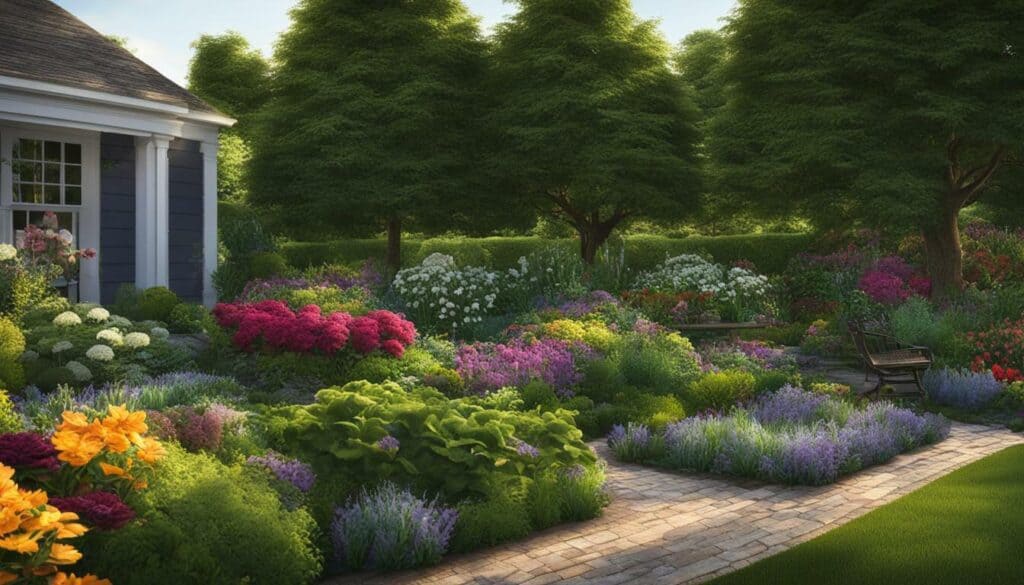
Expert Tip: Choose Native Plants
One of the best ways to meet your garden’s unique needs is by selecting native plants that are adapted to your specific region. Native plants are already acclimated to local climate conditions, making them easier to maintain and more likely to thrive. They also provide essential support for local pollinators, such as bees and butterflies. By incorporating native plants into your garden, you contribute to the conservation of local ecosystems and create a sustainable environment.
| Gardening Tip | Description |
|---|---|
| Watering | Water deeply once a week instead of lightly each day to encourage deep root growth and prevent shallow, weak plants. |
| Mulching | Apply a layer of mulch to garden beds to suppress weeds, conserve moisture, and regulate soil temperature. |
| Soil Drainage | Improve soil drainage by adding organic materials and amending soil quality. This will prevent waterlogging and enhance plant health. |
By implementing these gardening tips and tricks, you’ll establish a strong foundation for your garden and ensure its long-term success. Remember to stay attentive to your garden’s needs and make adjustments as necessary. Happy gardening!
Soil Preparation and Planting Techniques
The foundation of a successful garden lies in proper soil preparation and planting techniques. Whether you’re a beginner or an experienced gardener, these tips will help you get started on the right path.
First, it’s crucial to know your USDA Hardiness Zone. This information will guide you in selecting trees, shrubs, and perennials that can withstand the winter temperatures in your region. Planting the right species will ensure their survival and minimize the risk of losing your hard work to freezing temperatures.
Next, focus on improving your soil quality. Use only composted, rotted manure that has cured for at least six months when amending your soil. This organic matter provides essential nutrients and improves soil structure, resulting in healthier plants. Incorporating organic amendments like compost and well-aged manure will create a thriving environment for your garden to flourish.
Additionally, consider the specific needs of each plant. Understand the length of your growing season to determine when to start plants indoors or whether certain plants are suitable for your area. Providing the right amount of sunlight is crucial for plant growth and development. For example, vegetables typically require at least 8 hours of direct sunlight each day to yield a bountiful harvest.
Remember, successful gardening is a combination of proper soil preparation, suitable planting techniques, and considering the individual needs of your plants. By implementing these expert gardening tips, you can lay a solid foundation for a beautiful and thriving garden.
Caring for Perennials and Annuals
Perennials and annuals add vibrant colors and beauty to any garden. Discover how to care for these plants and ensure they bloom to their fullest potential. Whether you’re a seasoned gardener or just starting out, these flower gardening tips from Better Homes and Gardens will help you keep your perennials and annuals healthy and thriving.
| Seasonal Care | Key Actions |
|---|---|
| Spring | Prune spring-flowering shrubs, such as lilacs, immediately after the blooms fade. |
| Summer | Deadhead perennials and annuals to promote more flower production and stronger growth. |
| Fall | Leave ornamental grasses and seed heads of perennials in the fall to provide beauty and food for birds. |
| Winter | Plant spring-blooming bulbs in the fall before the ground freezes and deadhead spent flowers on daffodils and hyacinths. |
When caring for perennials and annuals, it’s important to provide the right amount of sunlight for different plants. Most perennials thrive in full sun, while some annuals may prefer partial shade. Ensure that your vegetable plants receive at least 8 hours of direct sunlight to promote healthy growth and abundant harvests.
In addition to sunlight, proper soil preparation and watering are crucial for the success of your flower garden. Improve soil quality by adding organic amendments like compost and well-aged manure. This will enhance the soil’s fertility and drainage, allowing your plants to thrive. Water garden plants deeply once a week instead of lightly each day to encourage deeper root growth and prevent moisture stress.
Remember to divide and transplant spring-blooming perennials in late summer or early autumn to maintain their health and vigor. And for those who love rhubarb, don’t forget to remove flower stalks to promote foliage production and ensure a bountiful harvest.
Expert Tip: Choose Native Plants
“Choose native plants adapted to your region for easier maintenance and better support for local pollinators.” – Better Homes and Gardens
One final tip to consider is selecting native plants that are adapted to your region. These plants are naturally suited to the local climate and environment, making them easier to care for and more beneficial to local pollinators. Incorporating native plants in your garden will create a beautiful and sustainable landscape while attracting bees, butterflies, and other important pollinators.
Maximizing Vegetable Gardening Success
Growing your own vegetables can be a rewarding experience. Whether you have a small backyard garden or a few pots on your balcony, there’s nothing quite like the satisfaction of harvesting fresh produce that you nurtured from seed to plate. To ensure your vegetable garden thrives, here are some expert tips and techniques:
Understanding Your Soil
The key to a successful vegetable garden starts with healthy soil. Before planting, assess your soil’s quality and composition. A well-draining soil that is rich in organic matter will provide the right foundation for your plants to grow. Consider conducting a soil test to determine its pH level and nutrient content. This will help you make any necessary amendments to achieve the optimal growing conditions for your vegetables.
Additionally, practicing crop rotation can help prevent soil-borne diseases and maintain soil fertility. By rotating the location of your vegetable beds each year, you can minimize the risk of pests and diseases that may have overwintered in the soil.
Choosing the Right Vegetables
Not all vegetables thrive in the same growing conditions. Take into account the amount of sunlight your garden receives and select vegetables accordingly. Leafy greens like lettuce and spinach, for example, prefer partial shade, while tomatoes and peppers require at least 8 hours of direct sunlight daily. Consider the space available in your garden and choose compact varieties or opt for vertical gardening techniques to maximize your harvest.
Proper Watering and Feeding
Watering is a critical aspect of vegetable gardening. Providing a consistent water supply is essential, especially during hot summer months. Aim to water deeply but infrequently to encourage deep root growth. Mulching around your plants can help retain moisture and suppress weeds.
In addition to water, vegetables also require adequate nutrients to thrive. Incorporating organic matter, such as compost and aged manure, into your soil can provide essential nutrients and improve soil structure. Consider using organic fertilizers or compost teas throughout the growing season to supplement your plants’ nutritional needs.
By implementing these tips and techniques, you can maximize your vegetable gardening success and enjoy a bountiful harvest of homegrown produce. Remember to stay attentive to your plants’ needs, closely monitor for pests and diseases, and adjust your gardening practices accordingly. Happy gardening!

Thriving with Container Gardening
Don’t let limited space stop you from gardening. Discover the secrets to thriving container gardens and bring your green thumb to new heights. Container gardening is a versatile and practical way to cultivate plants, whether you have a small balcony, a patio, or even just a sunny windowsill. With the right approach, you can create a stunning and productive garden in any space.
One of the key advantages of container gardening is the ability to control the soil and growing conditions. This means you can optimize the environment for specific plants and ensure they receive the proper amount of sunlight, water, and nutrients. Choose containers with good drainage and use high-quality potting mix to provide optimal growing conditions for your plants. Remember to select plants that are suitable for containers and consider their mature size to prevent overcrowding.
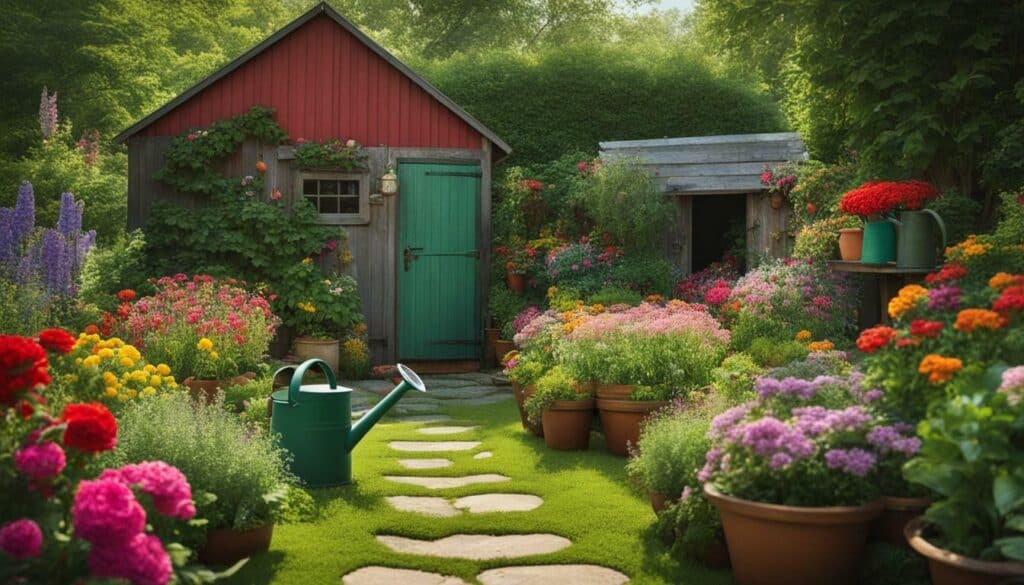
Another important aspect of successful container gardening is proper watering. Containers tend to dry out more quickly than garden beds, so it’s essential to monitor the moisture levels regularly. Water your plants deeply when the top inch of soil feels dry, ensuring the water reaches the bottom of the container. To prevent overwatering, make sure your containers have drainage holes to allow excess water to escape.
Lastly, don’t forget to feed your container plants regularly. Since the nutrients in container gardens can deplete more quickly than in-ground gardens, it’s crucial to provide them with a balanced fertilizer. Choose a slow-release or liquid fertilizer specifically formulated for container plants and follow the manufacturer’s instructions for application.
Container gardening allows you to unleash your creativity and experiment with an array of plants, from vibrant flowers to fresh herbs and even vegetables. By following these container gardening tips, you’ll be well on your way to creating a lush and thriving garden, no matter how small your space may be.
Seasonal Care and Maintenance
Stay on top of your garden’s needs year-round with these seasonal care and maintenance tips. Taking care of your garden throughout the seasons is crucial for its success and longevity. By following these expert gardening tips and tricks, you can ensure that your garden thrives in every season.
Spring
In spring, focus on preparing your garden for the growing season ahead. Start by cleaning up any debris, removing weeds, and pruning shrubs and trees that require it. This will promote healthy growth and prevent disease. It’s also the perfect time to sow seeds, transplant seedlings, and divide perennials. Remember to enrich your soil with compost and well-aged manure to provide essential nutrients for your plants.
Summer
During the summer months, it’s important to water your garden deeply and regularly, especially during dry spells. Mulching your garden beds will help retain moisture and suppress weed growth. Deadheading spent flowers will encourage further blooming, while regular pest monitoring and organic solutions will keep your plants healthy. Pay attention to the specific needs of each plant and provide adequate sunlight and shade accordingly.
Fall
In fall, prepare your garden for the coming winter. Clean up fallen leaves and add them to your compost pile or use them as mulch. It’s an ideal time to divide and transplant perennials, as well as plant spring-blooming bulbs. Remove any spent flower stalks and cut back ornamental grasses, leaving them at a height of around four inches for winter interest and bird feeding. Additionally, apply a layer of organic mulch to protect your plants’ roots from freezing temperatures.
Remember to tailor your care and maintenance routine to the specific needs of your garden, considering factors such as your hardiness zone, plant varieties, and local climate. By implementing these seasonal gardening practices, you can create a thriving, beautiful garden that brings you joy throughout the year.
| Season | Care and Maintenance Tips |
|---|---|
| Spring | Clean up debris, prune shrubs, sow seeds, and divide perennials. Enrich soil with compost. |
| Summer | Water deeply and regularly, mulch garden beds, deadhead spent flowers, and monitor pests. |
| Fall | Clean up fallen leaves, divide and transplant perennials, plant spring bulbs, and apply organic mulch. |
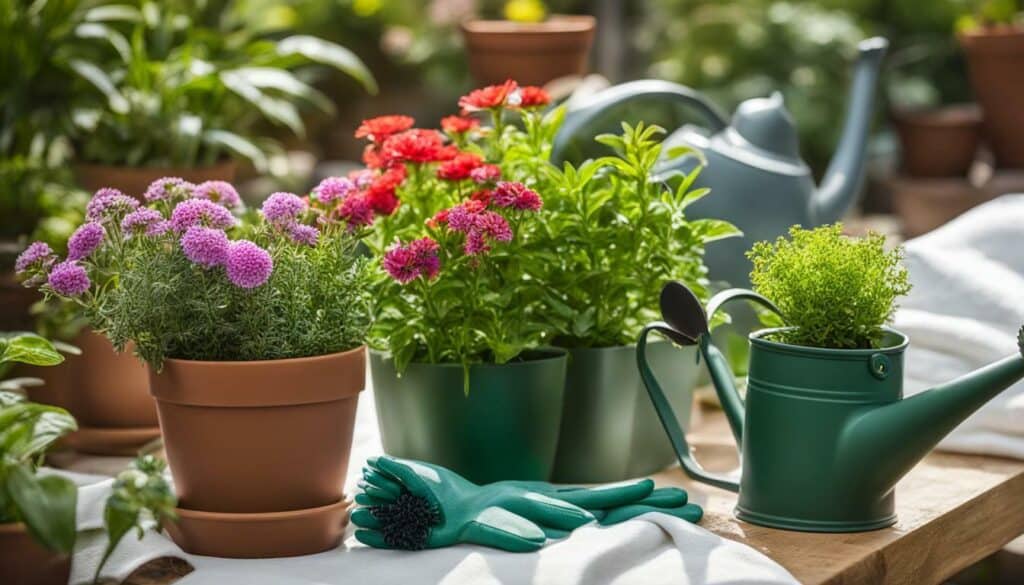
Special Considerations for Specific Plants
Different plants have different needs. Discover the specific care techniques for various plants to help them thrive in your garden. Whether you’re growing flowers or vegetables, understanding the unique requirements of each plant will ensure healthy growth and abundant blooms or harvests.
For flower gardening tips, consider the following:
- Prune spring-flowering shrubs, such as lilacs, immediately after the blooms fade.
- Deadhead perennials and annuals to promote more flower production and stronger growth.
- Leave ornamental grasses and seed heads of perennials in the fall to provide beauty and food for birds.
- Remove flower stalks from rhubarb to promote foliage production.
When it comes to vegetable gardening tips, keep these in mind:
- Provide the right amount of sunlight for different plants, ensuring at least 8 hours of direct sunlight for vegetables.
- Follow the optimal temperature range to ripen tomatoes and bring green fruits inside if temperatures consistently drop below 50°F.
- Mound potato plants deep to avoid green skin caused by exposure to light.
- Water garden plants deeply once a week instead of lightly each day.
Remember, these tips are just a starting point. Consult plant-specific resources and experiment to find the best practices for your unique garden. Happy gardening!
| Flower Gardening Tips | Vegetable Gardening Tips |
|---|---|
| Prune spring-flowering shrubs after blooms fade | Provide at least 8 hours of direct sunlight for vegetables |
| Deadhead perennials and annuals for more flowers | Ripen tomatoes within optimal temperature range |
| Leave ornamental grasses and seed heads for beauty and birds | Mound potato plants to avoid green skin |
| Remove flower stalks from rhubarb for more foliage | Water deeply once a week |
Image:
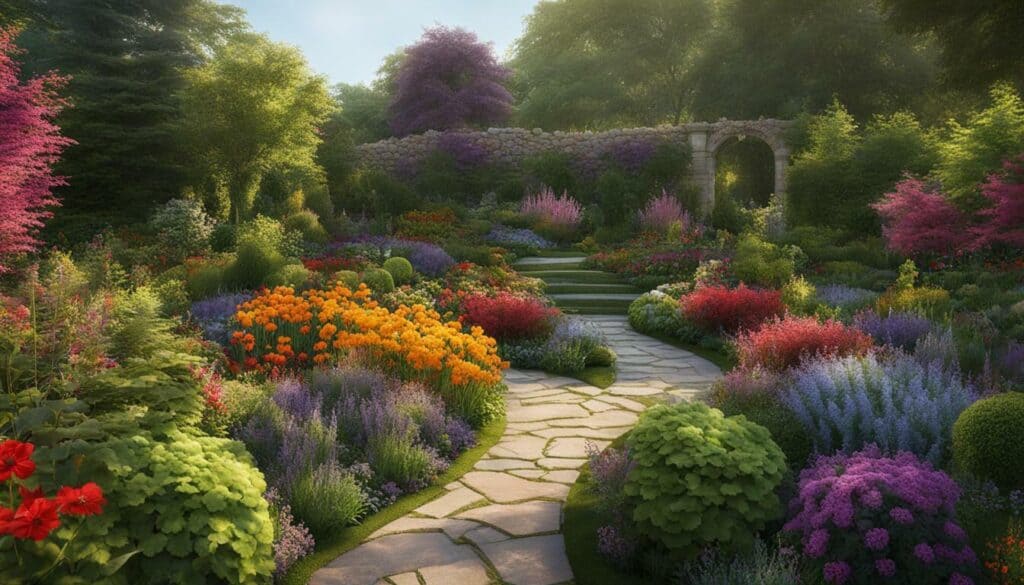
Sustainable Gardening Practices
Embrace sustainable gardening practices and learn how to create a garden that is not only beautiful but also promotes the well-being of the planet. By incorporating organic gardening tips, you can minimize the use of chemicals and create a more environmentally friendly space.
One key aspect of sustainable gardening is improving soil quality. Focus on adding organic amendments like compost and well-aged manure to enrich the soil and provide essential nutrients for plants. This not only improves plant health but also promotes healthy soil microbial activity.
Another important practice is conserving water. Instead of watering lightly every day, water garden plants deeply once a week. This helps establish deep root systems and minimizes water waste. Additionally, consider using fallen leaves as compost ingredients or mulch over tender perennials to retain moisture in the soil and prevent weed growth.
| Practices | Benefits |
|---|---|
| Improving soil quality with organic amendments | Enhanced plant health and healthy soil ecosystem |
| Conserving water through deep watering and mulching | Minimized water waste and reduced weed growth |
Additionally, consider choosing native plants adapted to your region. These plants are better acclimated to local weather conditions and require less maintenance. They also provide essential food and habitat for local pollinators, supporting biodiversity in your garden.
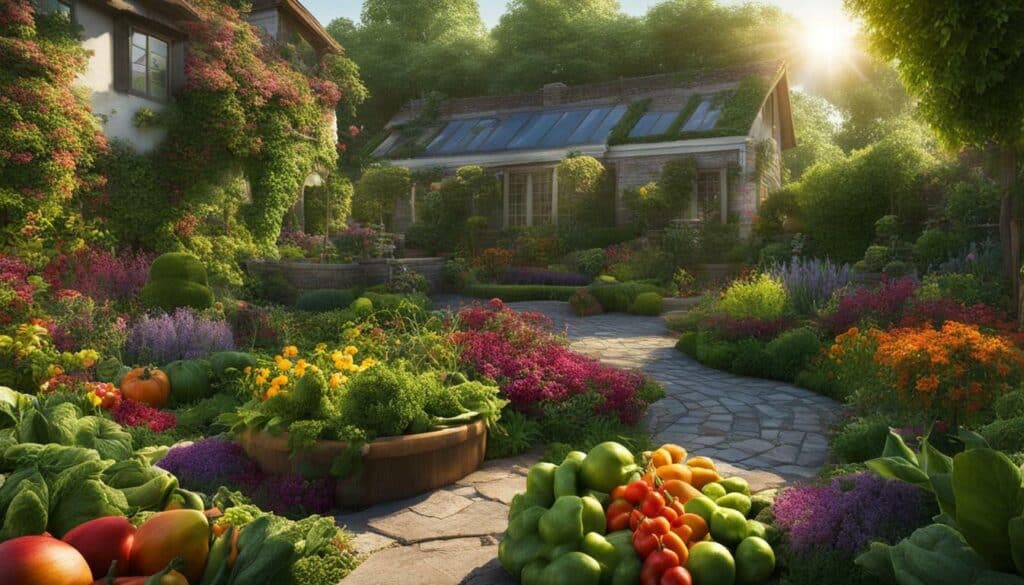
Troubleshooting Garden Issues
Dealing with garden problems? Don’t worry, I’ve got you covered. Learn how to identify and solve common garden issues with these expert tips.
Common Pest Problems and Solutions
One of the most frustrating garden issues is dealing with pests. Whether it’s aphids attacking your roses or slugs munching on your greens, pests can wreak havoc on your plants. To tackle this problem, try using organic solutions like neem oil or insecticidal soap. These products are effective in controlling pests without harming beneficial insects. Additionally, practicing good garden hygiene by removing debris and regularly inspecting your plants can help prevent pest infestations.
Disease Prevention and Management
Garden diseases can quickly spread and cause significant damage to your plants. To prevent diseases, make sure your plants have adequate spacing and good air circulation. Avoid overhead watering, as this can promote the spread of fungal diseases. If you do notice signs of disease, such as leaf spots or wilting, act promptly. Remove and destroy affected plant parts to prevent the disease from spreading further. Applying organic fungicides, like copper-based sprays, can also help control fungal infections.
Nutrient Deficiencies and Soil Imbalances
Healthy plants require well-balanced soil nutrients. If you notice yellowing leaves, stunted growth, or poor fruit production, your plants may be experiencing nutrient deficiencies. Conduct a soil test to identify any imbalances and adjust accordingly. Organic amendments like compost and well-aged manure can help improve soil fertility. Additionally, adding organic fertilizers, such as bone meal or fish emulsion, can provide the necessary nutrients for optimal plant growth.
| Garden Problem | Solution |
|---|---|
| Pest infestations | Use organic pest control products, practice good garden hygiene, and regularly inspect plants. |
| Diseases | Ensure proper plant spacing, good air circulation, and promptly remove affected plant parts. Apply organic fungicides if necessary. |
| Nutrient deficiencies | Conduct a soil test, amend with organic matter, and use organic fertilizers to provide necessary nutrients. |

With these expert tips and solutions, you can overcome common garden issues and ensure your plants thrive. Remember, prevention is key, so regular monitoring and proactive measures can help keep your garden healthy and vibrant. Happy gardening!
Conclusion
With these expert Better Homes and Gardens gardening tips, you’re well-equipped to create a flourishing garden that will delight you for years to come. By understanding your garden’s specific needs, preparing the soil properly, and utilizing effective planting techniques, you can ensure optimal growth and health for your plants.
Caring for perennials and annuals, maximizing vegetable gardening success, and thriving with container gardening are all essential aspects of creating a beautiful and productive garden. Remember to provide seasonal care and maintenance, and consider the special considerations for specific plants to promote optimal growth and health.
Incorporating sustainable gardening practices, such as organic gardening tips, not only benefits your garden but also contributes to a healthier and more environmentally friendly ecosystem. Additionally, troubleshooting common garden issues with the help of expert advice will ensure your garden remains pest-free and vibrant.
By following these tips and implementing Better Homes and Gardens’ gardening expertise, you can transform your garden into a thriving haven filled with vibrant flowers, bountiful vegetables, and a sense of pride. Enjoy the rewards of your hard work and watch as your garden flourishes and brings joy throughout the seasons.
What Are Some Expert Tips for Home Garden Work Success?
Achieving success in home garden work requires a combination of knowledge, skill, and dedication. Here are some expert home garden tips and techniques to help you thrive. Firstly, choose plants that suit your climate and soil conditions. Secondly, provide adequate sunlight and maintain proper watering levels. Additionally, regular pruning and fertilizing will promote healthy growth. Remember to regularly monitor pest and disease issues and take appropriate measures. And lastly, commit to consistent maintenance to ensure your home garden flourishes.
FAQ
Q: What is the USDA Hardiness Zone?
A: The USDA Hardiness Zone is a way to classify regions based on their average annual minimum temperature. It helps gardeners determine which plants are suitable for their area.
Q: When should I prune spring-flowering shrubs?
A: Spring-flowering shrubs, such as lilacs, should be pruned immediately after the blooms fade to promote healthier growth for the following year.
Q: What type of manure should I use for my soil?
A: It is recommended to use composted, rotted manure that has cured for at least six months to enrich your soil with nutrients without the risk of burning your plants.
Q: How long does it take for perennials to reach their mature size?
A: Perennials generally need three years to reach their mature size after planting. Patience is key when it comes to their development.
Q: How can I promote more flower production in my garden?
A: Deadheading perennials and annuals by removing spent flowers can encourage continuous blooming and promote stronger growth in your garden.
Q: How much sunlight do vegetables need?
A: Vegetables generally require at least 8 hours of direct sunlight daily to thrive and produce a bountiful harvest.
Q: What is the best method for weed control in my garden?
A: Hand-weeding and hoeing are effective methods for weed control, and using mulch can help smother and prevent annual weeds from taking over your garden.
Q: When is the best time to divide hostas?
A: Hostas should be divided in spring or fall, about four weeks before the soil freezes solid, to ensure successful transplanting and healthy growth.
Q: Do all hydrangeas require full sun for flowering?
A: Some hydrangeas, like panicle hydrangeas, actually need full sun exposure to produce their best flowering display.
Q: Should I leave ornamental grasses and seed heads in the fall?
A: Yes, leaving ornamental grasses and seed heads of perennials in the fall can provide beauty to your garden and serve as a valuable food source for birds.
Q: What temperature range is ideal for ripening tomatoes?
A: Tomatoes ripen best when the temperatures range between 70-85°F. If temperatures consistently drop below 50°F, it is recommended to bring green fruits indoors and allow them to ripen.
Q: When should I plant spring-blooming bulbs?
A: Spring-blooming bulbs should be planted in the fall, before the ground freezes, to ensure they establish properly and bloom beautifully in the spring.
Q: How can I improve soil quality in my garden?
A: Improving soil quality can be achieved by incorporating organic amendments like compost and well-aged manure, which provide essential nutrients and improve soil structure.
Q: When is the best time to divide and transplant spring-blooming perennials?
A: Late summer or early autumn is the ideal time to divide and transplant spring-blooming perennials to minimize stress and allow them to establish before winter.
Q: Should I remove flower stalks from rhubarb?
A: Yes, removing flower stalks from rhubarb is recommended to redirect the plant’s energy toward foliage production and ensure a bountiful harvest.
Q: How should I transplant container-grown perennials?
A: When transplanting container-grown perennials, dig a hole twice as wide as the soil ball and plant at the same depth to allow the roots to establish properly.
Q: How can I prevent green skin on potatoes?
A: To avoid green skin on potatoes, mound the plants deep by adding soil as the plant grows. This will help prevent exposure to light, which causes green skin.
Q: How often should I water my garden plants?
A: It is best to water garden plants deeply once a week, ensuring the water reaches the root zone, rather than watering lightly every day. This promotes stronger root growth and conserves water.
Q: What can I do with fallen leaves in my garden?
A: Fallen leaves can be utilized as compost ingredients or used as mulch to protect and insulate tender perennials during the colder months.
Q: Should I avoid planting in wet soil?
A: Yes, it is advisable to avoid digging or planting in wet soil as it can damage soil structure and hinder proper root development. Wait for the soil to dry out before working in your garden.
Q: How can I improve soil drainage?
A: To improve soil drainage, add organic materials such as compost and amend the soil quality by incorporating materials like sand or perlite, which help create air pockets in the soil.
Q: Why should I choose native plants for my garden?
A: Choosing native plants adapted to your region offers easier maintenance and provides better support for local pollinators, contributing to a healthier and more sustainable ecosystem.
Q: How can I practice sustainable gardening?
A: Sustainable gardening can be achieved by using fewer chemicals, opting for organic solutions for pest and disease control, and incorporating practices like composting and water conservation into your gardening routine.
Q: What can I do to prevent weeds in my garden?
A: Mulching garden beds can help prevent weed growth by smothering weeds and conserving moisture in the soil, reducing the opportunity for weeds to take hold and thrive.
Q: What should I do if I encounter garden issues like pests or diseases?
A: When faced with garden issues, it is advisable to seek expert gardening advice and explore organic solutions to minimize the use of chemicals and promote a healthier garden environment.

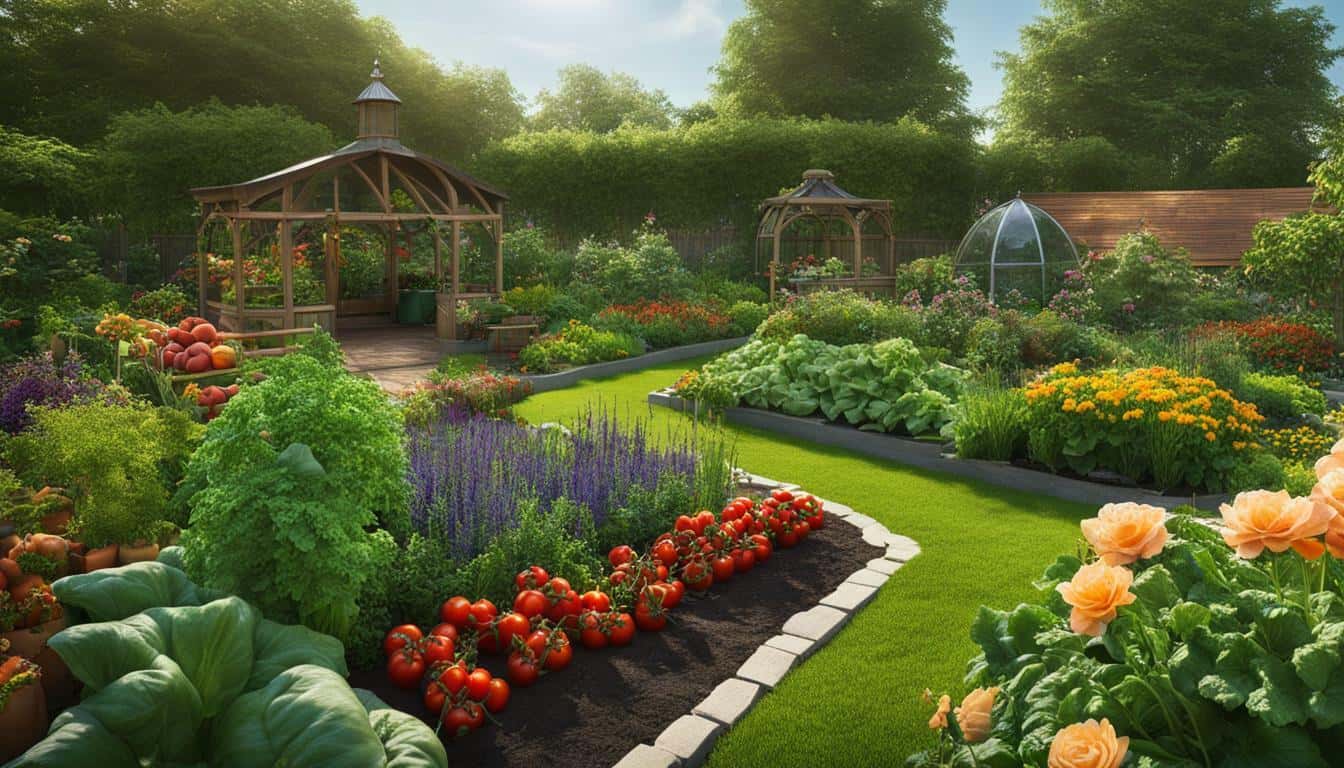



Leave a Reply